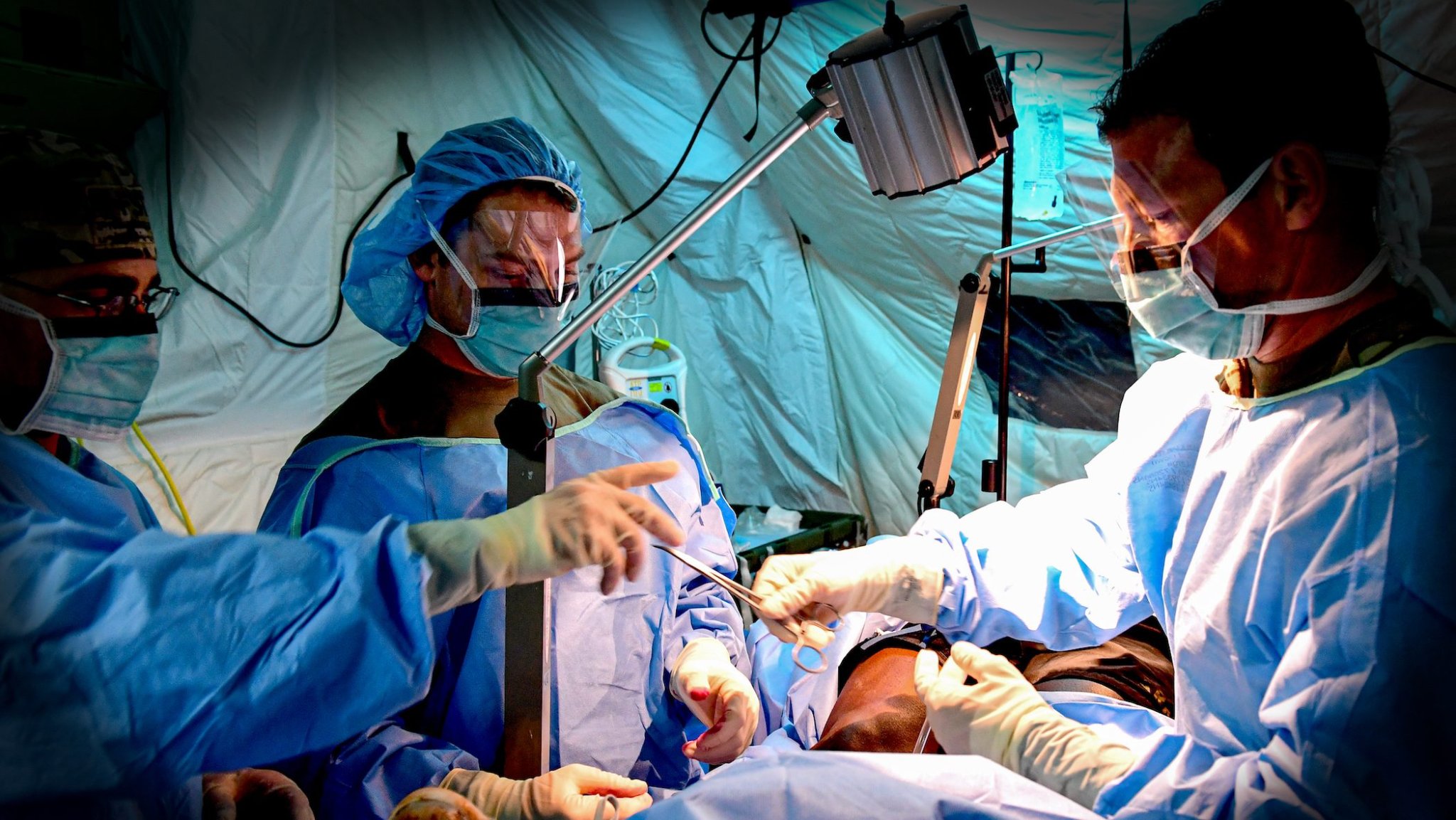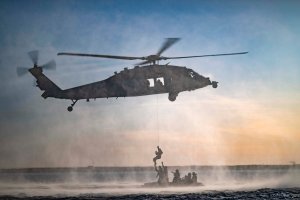

Military doctors and nurses are not getting enough hands-on patient care, leaving them ill-prepared to care for troops in combat and causing them to separate from service altogether, according to a federal watchdog.
“Because Army and Navy medical personnel are not consistently assigned where they can sustain their wartime readiness skills, they may not provide high quality, point-of-injury care to service members during deployments,” a Department of Defense Inspector General report released this month found.
The problem was most acute for Army and Navy personnel, compared to the Air Force. According to the report, emergency and trauma-focused medical officers were assigned to locations “that do not provide opportunities for direct patient care.” Instead, based on IG observations and conversations with medical personnel, they were assigned to one of the seven Navy fleets, a Marine Corps unit or Army Forces Command, where they saw a low volume of relevant cases and situations that lacked medical complexity.
The report focused specifically on critical care physicians and nurses, anesthesiologists, nurse anesthetists, emergency medicine doctors and trauma nurses, which are generally held by officers. Those roles are different from Navy corpsmen and Army and Air Force combat medics, who are enlisted military personnel organic to military units across the force, and in combat arms fields are tasked with providing frontline medical care.
The wartime skills that medical officers are expected to maintain differ between services and by occupation, but overall, they are expected to perform combat casualty care in hospitals, which includes life-saving trauma surgeries or procedures to preserve limbs.
The Army and Navy “did not consistently assign” medical personnel to military treatment facilities or civilian hospital partnership programs, which provide the most opportunities,” to meet readiness requirements, the IG said. Only 25% of Army, 52% of Navy and 81% of Air Force emergency doctors were placed at locations where they directly provided care to patients.
Army officials told the IG that they did not account for personnel assigned to operational units but have duties at military hospitals, where they are required to spend 88% of their time according to policy. The IG did not confirm if personnel met this policy requirement.

The assignment issues led to poor outcomes for physician and nurse combat readiness. April 2025 data showed that officers’ medical skills often fell below readiness standards, even with each department having different requirements.
For instance, one annual training requirement involves medical officers placing flexible catheter tubes into arteries to monitor patients’ blood pressure. The Army requires critical care doctors to do two arterial lines each year, the Air Force requires 10, and the Navy scores arterial line procedures instead of requiring a certain number of them. The IG found that 9% of Army doctors, 25% of Navy doctors and 41% of Air Force doctors met their annual threshold. Overall, the IG found that the Air Force had more medical personnel in compliance with their readiness requirements.
The readiness concerns highlighted by the IG report echoed similar findings from the Government Accountability Office, but for enlisted personnel. The GAO found in a 2021 report that “the military departments lack reasonable assurance that all enlisted medical personnel are ready to perform during deployed operations.”
Leaving the service
The long-term effect, the IG found, is that medical personnel in “wartime specialties” — like emergency care and trauma surgery — may end up separating because of the lack of opportunities for hands-on experience.
A January 2024 Medical Corps Retention and Burnout Study cited in the report, which included a survey of emergency medicine doctors, found concerns over skill degradation listed as the most common reason for junior officers to leave the service.
“My biggest reason for wanting to get out is simply because I desire to do emergency medicine,” one medical service member said on the survey.
The IG said that these issues exacerbate existing medical personnel shortages.
An April 2024 Defense Department report to Congress looked at Walter Reed National Military Medical Center in Bethesda, Maryland, one of the military’s largest hospitals, and found that it was operating with only 68% of its authorized spots for nurses.
A September 2024 RAND Corporation report found that the Army’s recruitment of doctors has not been able to keep up with the rate of separations, which in turn led to unfilled positions at hospitals and other units and “compromising” the medical corps’ mission in deployed settings.
Personnel tell IG they want more hands-on experience
Wartime readiness is not a new issue for military medical personnel.
The IG cited prior studies referring to a “peacetime effect,” noting that for those who are stateside, it’s harder to maintain the kinds of skills they’d most likely rely on in a combat zone. A 2023 Institute for Defense Analyses report stated that Iraq and Afghanistan revealed significant medical readiness challenges because of their primary training at military hospitals.
“This results in an unready medical force at the onset of another war,” the IG said.
The IG interviewed 35 medical personnel across three services. In interviews with those assigned to military hospitals, the officers told the IG in interviews that they couldn’t complete enough trauma and emergency medical procedures “to maintain the skills necessary to provide care in an operational setting.”
One critical care doctor assigned to the largest treatment facility — the report didn’t specify which hospital — told the IG that they had only performed 10 procedures independently since 2018. In comparison, they did 950 procedures as an off-duty volunteer at a civilian hospital and during a nine-month deployment, according to the report. Although the doctor did supervise medical residents and fellows at the military hospital, they told the IG that they needed to personally complete medical procedures rather than observe them “to feel ready to care for service members in a deployed environment.”

Army officials said simulation and training devices supplement their training and “increase proficiency in specific skills.” In 2024, the Army began incorporating female-specific simulators and manikins to improve medic training and response to women’s injuries in battle.
Medical personnel interviewed by the IG recommended that the services offer more training with civilian hospitals. The Institute for Defense Analyses recommended that the military branches expand those civilian opportunities, but the IG found that “only a small percentage” of personnel were permanently assigned to civilian hospitals.
In 2016, Vice Adm. Forrest Faison, the Navy surgeon general at the time, established partnerships with hospitals in Chicago and Los Angeles. The service also allows Navy medical personnel to train at civilian hospitals for certain specialties like surgery.
In 2019, the Army announced a program for 10 doctors and nurses to do a two-to-three year stints at civilian hospitals in New Jersey and Oregon. The program was new for the service at the time and directed by Congress in the fiscal year 2017 defense bill. It has since expanded to medical centers in Washington, Illinois, and Tennessee.
The Army has also partnered with civilian trauma centers for training enlisted soldiers like combat medics, operating room technicians and practical nurse specialists.
Earlier this month, the Navy announced a new partnership with the Morongo Basin Ambulance Association in Joshua Tree, California, for its corpsmen to take part in emergency call ride-alongs with civilian paramedics for “hands-on ambulance training.”
The IG also found that Army and Navy policies did not emphasize the importance of civilian partnerships, while the Air Force is requiring 80% of positions at its military-civilian programs be filled as part of a 2023 staffing plan.
However, the IG also found that when the departments did pursue civilian partnerships, the Defense Health Agency didn’t track performance, which could influence where and when the branches assign their personnel.
The GAO had similar findings in 2021 and recommended that DHA develop an inventory of civilian partnerships. Defense officials told the GAO that it was coming up with a process to identify civilian training opportunities by the end of 2025.
The latest on Task & Purpose
- Operation Midnight Hammer damaged, but may not have destroyed Iran’s nuclear sites
- An Army base will now honor a Buffalo Soldier
- 2 aircraft carriers, 9 destroyers, and multiple fighter wings gather in the Middle East
- Marines and sailors are building trenches for the drone age
- The Army is deactivating police units in deep cuts to number of military cops
